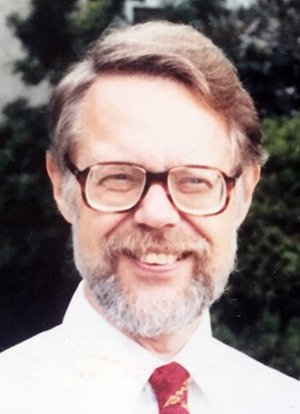In Honor of Retired Physics Professor Mark Heald

President Valerie Smith shared the following message with the campus community on July 28, 2020:
Dear Friends,
With deep sadness, I write to share the news that Mark A. Heald, the Morris L. Clothier Professor Emeritus of Physics, died July 12. He was 91.
Mark retired from Swarthmore in 1992 after serving 33 years on the faculty. He is survived by his wife of 68 years, Jane D. Heald, and their three children.
I invite you to read more below about Mark and his many contributions to our community.
Sincerely,
Val Smith
President
In Honor of Professor Emeritus Mark Heald
An expert on electromagnetism, Mark A. Heald, the Morris L. Clothier Professor Emeritus of Physics, died Sunday, July 12, at age 91.
“Mark was a talented experimentalist, a classic physicist of the mid-to-late 20th century,” says Amy Graves, the Walter Kemp Professor in the Natural Sciences and Professor of Physics. “The activities he planned were true to what students would do in real-world electronics labs at that time.”
“Mark was dedicated to developing course laboratories of the highest quality,” adds Peter Collings, the Morris L. Clothier Professor Emeritus of Physics. “He wrote detailed laboratory manuals for the students and throughout his career worked tirelessly to improve them.”
Heald grew up in Princeton, N.J. At age 8 while out with his parents for a drive about 50 miles from home, he witnessed the fiery demise of the Hindenburg zeppelin. In the seconds before it was engulfed in flames, he observed a phenomenon that many years later would ultimately help confirm what sparked the fire, and which also perhaps provided the throughline to his professional life.
Growing up, Heald was active with the local Boy Scout troop and taught himself the alto saxophone in order to play in his classmates’ Glenn Miller-style dance band. After graduating from Princeton High School in 1946, he followed his father and paternal grandfather in attending Oberlin College.
In 1950, Heald graduated from Oberlin with a B.A. in physics. At Oberlin, he also met Jane Dewey. By the time they married on her graduation day in 1952, he had already begun graduate studies at Yale University, where he earned an M.S. and a Ph.D. in experimental atomic physics in 1954.
Noting that Heald entered physics roughly at the start of the Cold War, former colleague Frank Moscatelli says, “What impressed me were his stories about participating in some early but fateful periods in physics.” Moscatelli, the Edward Hicks Magill Professor Emeritus of Physics, adds that Heald “was among the first members of the group at Princeton studying nuclear fusion, in particular its use in producing electricity, which is still not achieved.”
Indeed, in 1954, Heald signed on as the group leader for microwave diagnostics of magnetically confined plasmas at Princeton University’s Project Matterhorn, a classified project studying the hydrogen bomb and the precursor of the Princeton Plasma Physics Laboratory. When the work toward controlled fusion in stellarators, or plasma devices, was declassified in 1958, Princeton exhibited a working stellarator that year at the United Nations’ “Atoms for Peace” convention and exhibition in Geneva, Switzerland.
As a technological delegate at the event, Heald helped plan the displays and captioning of the exhibit at what proved to be one of the first international conferences on the peaceful use of nuclear physics, fission, and fusion. From this work, he and Charles Wharton of Cornell University published a monograph, Plasma Diagnostics with Microwaves (1965).
Heald joined Swarthmore’s physics faculty in 1959 as part of the department’s expansion and relocation to the then-new DuPont Science Center. During his 33-year tenure, his primary teaching interests included electromagnetism, classical mechanics, and physical optics. He also served as department chair from 1968 to 1978 and served on committees in the 1970s that focused on the College’s Honors Program and its accreditation process.
Heald continued his involvement with plasma research during sabbatical leaves from Swarthmore at Princeton, MIT’s Plasma Science and Fusion Center, and the Culham Centre for Fusion Energy in the U.K. He co-authored two textbooks: Physics of Waves (1969), which Moscatelli describes as ahead of its time, with his senior Swarthmore colleague in physics Bill Elmore; and the second edition of Classical Electromagnetic Radiation (1980) with Jerry Marion, and to which Heald provided significant revisions for the third edition. He also served a term as associate editor of the American Journal of Physics, to which he was a frequent contributor. For many years, Heald helped select the recipients of the Franklin Institute medals that are awarded annually for extraordinary contributions to science and technology.
Heald retired from the College in 1992, and moved with his wife six years later to a retirement community in rural Pleasant Hill, Tenn. There, he worked with the Pleasant Hill Child Enrichment Center, the town’s recycling program, and the community musical ensemble.
More than 75 years after the Hindenburg’s 1937 crash, Heald’s memories of the disaster — and the “little bit of blue fire” he spotted on the rudder momentarily before the airship became engulfed in flames and crashed — helped confirm what had been an enduring mystery: that static electricity had ignited leaking hydrogen and sparked the precipitating blaze. The weather phenomenon that Heald described, also known as St. Elmo’s Fire, is a form of plasma — the primary focus of his research and teaching over the years.
Heald’s former students remembered him well. In reflecting on what makes a good teacher in a 2009 issue of the Bulletin, a Class of 1977 alum said he “distilled each problem to its essentials and provided elegant, concise solutions. He made the physics enjoyable.”


